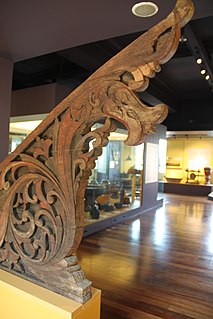 W
WBali-og, also spelled baliog, are traditional layered necklaces of various ethnic groups in the islands of Visayas and Mindanao in the Philippines. They consist of chokers and necklaces with a fringe of beads and other ornaments. More than one is usually worn, layered over each other. Their elements usually consist of metal or glass beads, hollowed seeds, seashells, mother-of-pearl, and copper or brass ornaments.
 W
WThe Cultural Center of the Philippines is a government owned and controlled corporation established to preserve, develop and promote arts and culture in the Philippines. The CCP was established through Executive Order No. 30 s. 1966 by President Ferdinand Marcos. Although an independent corporation of the Philippine government, it receives an annual subsidy and is placed under the National Commission for Culture and the Arts for purposes of policy coordination. The CCP is headed by an 11-member Board of Trustees, currently headed by Chairperson Margarita Moran-Floirendo. Its current president is Arsenio Lizaso.
 W
WLetras y figuras is a genre of painting pioneered by José Honorato Lozano during the Spanish colonial period in the Philippines. The art form is distinguished by the depiction of letters of the alphabet using a genre of painting that contoured shapes of human figures, animals, plants, and other objects called Tipos del País popularized by Damián Domingo. The letters depicted spell out a phrase or a name, usually that of the patron who commissioned the work. The paintings were done with watercolor on Manila paper. The earliest example of this art form dates from 1845; the latest existing specimens were completed during the latter portion of the American period in the 1930s during the administration of the Commonwealth of the Philippines.
 W
WThe Order of National Artists of the Philippines is an order bestowed by the Philippines on Filipinos who have made significant contributions to the development of Philippine art. Members of the Order are known as National Artists. Originally instituted as an award, it was elevated to the status of an order in 2003.
 W
WThe National Commission for Culture and the Arts of the Philippines is the official government agency for culture in the Philippines. It is the overall policy making body, coordinating, and grants giving agency for the preservation, development and promotion of Philippine arts and culture; an executing agency for the policies it formulates; and task to administering the National Endowment Fund for Culture and the Arts (NEFCA) – fund exclusively for the implementation of culture and arts programs and projects.
 W
WThe National Living Treasures Award, alternatively known as the Gawad sa Manlilikha ng Bayan is conferred to a person or group of artists recognized by the Government of the Philippines for their contributions to the country's intangible cultural heritage. A recipient of the award, a National Living Treasure or Manlilikha ng Bayan is "a Filipino citizen or group of Filipino citizens engaged in any traditional art uniquely Filipino, whose distinctive skills have reached such a high level of technical and artistic excellence and have been passed on to and widely practiced by the present generations in their community with the same degree of technical and artistic competence."
 W
WOkir or okil is the term for rectilinear and curvilinear plant-based designs and folk motifs that can be usually found among the Moro and Lumad people of the Southern Philippines, as well as parts of Sabah. It is particularly associated with the artwork of the Maranao and Sama (Badjao) tribes, although it can also be found to a lesser extent among the Maguindanao, Iranun, Tausug, Yakan, and Lumad groups. The design elements vary among these ethnic groups, with the greatest refinement being found among the Maranao.
 W
WArts in the Philippines refer to all the various forms of the arts that have developed and accumulated in the Philippines from the beginning of civilization in the country up to the present era. They reflect the range of artistic influences on the country's culture, including indigenous forms of the arts, and how these influences have honed the country's arts. These arts are divided into two distinct branches, namely, traditional arts and non-traditional arts. Each branch is further divided into various categories with subcategories.
 W
WUGATLahi Artist Collective is a visual artists' organization based in the Philippines. The group was started in the early 1990s. The group creates images of protest. Since 2001, they have created effigies of the Philippine president for each State of the Nation Address. The group is also active in performance and installation art.